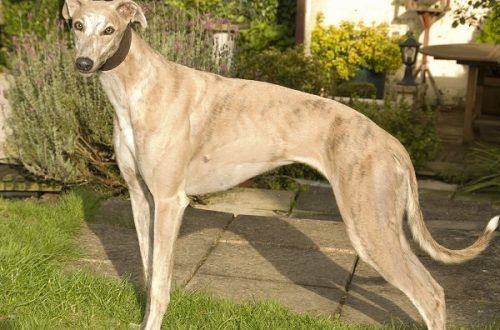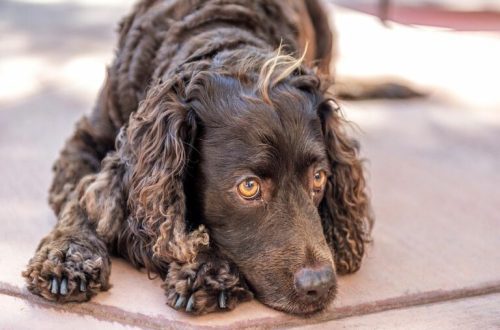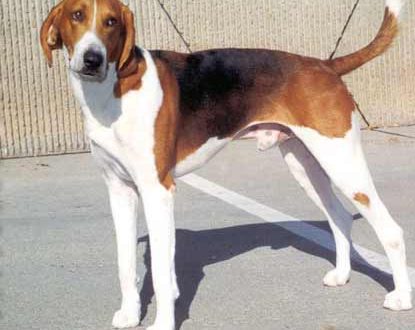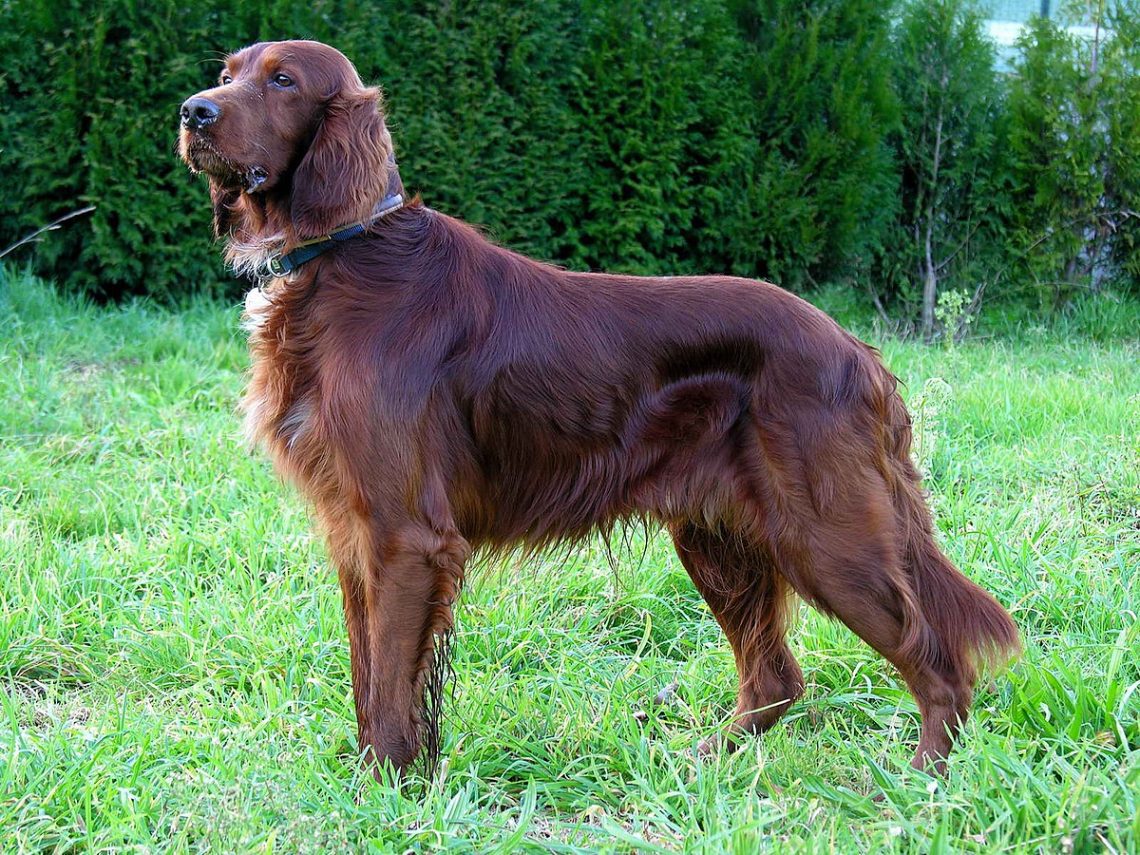
Irish Setter
Other names: Irish Red Setter
The Irish Setter (Irish Red Setter) is a hunter, extroverted intellectual and adept at an active lifestyle with a luxurious chestnut coat.
Contents
- Characteristics of Irish Setter
- Basic moments
- History of the Irish Setter breed
- Irish Setter breed standard
- Photo of Irish Setter
- Personality of the Irish Setter
- Education and training
- Hunting with an Irish Setter
- Maintenance and care
- Irish Setter Health and Disease
- How to choose a puppy
- Photos of Irish Setter puppies
- Irish Setter price
Characteristics of Irish Setter
| Country of origin | Ireland |
| The size | large |
| Growth | 58–70 cm |
| Weight | 14–32 kg |
| Age | 10–14 years old |
| FCI breed group | cops |
Basic moments
- The Irish Setter is an ultra-sociable, affectionate dog, unable and unwilling to put up with loneliness, so it is undesirable to get it for workaholics who spend days at work.
- Lack of suspicion and goodwill towards humans and pets make Irish Red Setters absolutely no watchdogs.
- Modern show representatives of the breed are more companions and family therapists than full-fledged hunters. At the same time, individuals from the working lines perfectly cope with their historical mission – the detection and frightening of wild birds.
- The breed is quite athletic and requires the same from the owner, so you will have to forget about 15-minute walks for show.
- Despite the fact that Irish Setters are peaceful and accommodating creatures, it is not easy to convince them of anything.
- If in the summer an open reservoir turned out to be in the field of view of a pet, in 9 cases out of 10 it will rush to swim, forgetting about everything in the world.
- Emphasized aristocratic image of the Irish Red Setter – this is necessarily time, money and work. Without systematic washing, combing, the use of professional dog cosmetics and vitamins, it will not work to keep the pet’s coat in a decent form.
- In puppyhood, the “Irish” are hyperactive and destructive, and it is pointless to correct the destructive behavior of the baby, he just has to outgrow this period.
- The coat of the Irish Setter does not have a pronounced dog odor. Dogs shed very little, and the fallen undercoat does not fly in the air and does not settle on things and furniture.
- The breed is slow maturing. Irish Setters reach full mental maturity no earlier than three years.
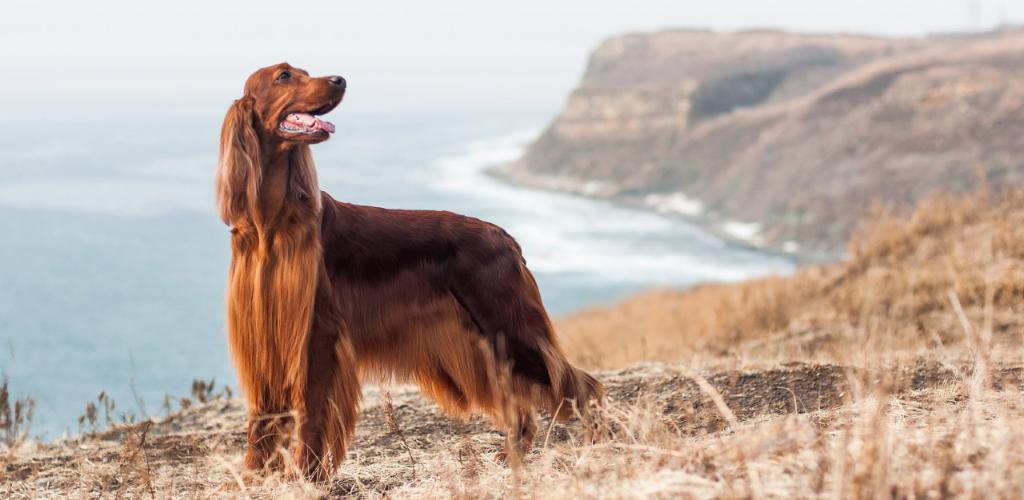
The Irish Setter is a charming, intelligent, smart dog with a positive attitude towards life and others. Sometimes a little too gullible, but able to stand his ground, this chestnut handsome is the type of pet in which you never tire of discovering unexpected qualities. Hunting with an Irish Setter is a topic worthy of a separate article. It is possible to return from the field without prey with a dog only in one single case – if there was not a single feathered creature on this field initially.
History of the Irish Setter breed
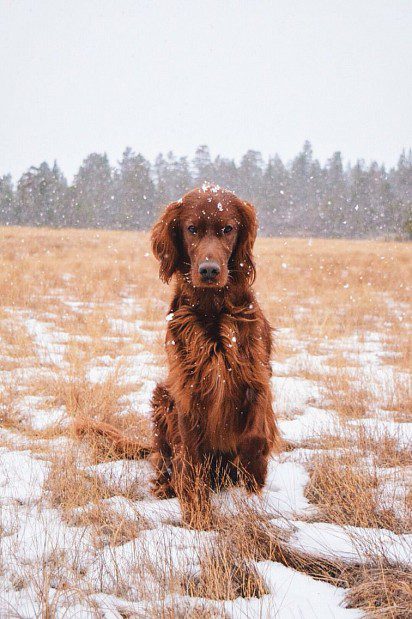
The Irish Red Setter is one of the most “secret” hunting breeds, the first written mention of which dates back to the 15th century. At first, the term “setter” did not refer to a specific type of dog, but to entire groups of animals, whose main qualification was work with wild birds. In particular, setters were often used to hunt partridges with a net. Possessing an extremely sharp instinct, the dogs have always accurately located the prey and indicated the direction to it, acting as a living navigator.
Little is known about the closest relatives of Irish Setters. There is an assumption that the blood of several varieties of spaniels, bloodhounds, pointers and even wolfhounds flows in the veins of modern representatives of the breed. However, it has not yet been possible to confirm the conjectures. Purposefully bred hunting dogs with reddish chestnut hair in Ireland began at the end of the 18th century, as evidenced by the stud books of those years. Nevertheless, until the middle of the 19th century, the breed was not considered formed, therefore, in the rings, animals performed in groups with other varieties of setters. The official starting point for the history of the breed is considered to be 1860, when it was decided to separate the Irish Setters into a separate type. In 1882, the first Red Irish Club opened in Dublin.
An interesting fact: at the turn of the XIX-XX centuries. in Europe, they practiced crossing the exhibition and hunting varieties of the Irish setter. Such experiments entailed a number of problems, including the degeneration of the breed traits of animals, due to which mating between working and show lines had to be stopped. American breeders, on the contrary, were fond of improving mainly exhibition individuals, so today’s “Irish” made in USA are somewhat different from their overseas compatriots.
In Russia, Irish Setters were known even before the revolution. Moreover, elite nurseries operated in the country, patronized by members of princely families. But even after the change of state system, the breed was not forgotten: they continued not only to breed it, but also to actively improve it, importing purebred European producers into the Union. For example, A. Ya. Pegov, a professional breeder and author of the book Irish Setter, which became the “bible” of domestic dog breeders for more than half a century, played an outstanding role in popularizing the “Irish” in the USSR.
It is worth noting that Russia has always relied on breeding animals of hunting lines, which means that domestic livestock have never traveled to international exhibitions. Later, E. E. Klein and T. N. Krom intercepted the baton of Pegov, who modified the type of dogs towards leaner and more muscular, which allowed the Soviet setters to approach the Anglo-Irish breed ideal a little.
Video: Irish Setter
Irish Setter breed standard
If the tops of the most sophisticated individuals were compiled for hunting dogs, the Irish setters would shine in the first places in them. High-legged, with a proud posture, smooth, swift movements, these self-sufficient “gentlemen” are a model of intelligence and restrained charm. By the way, it is this feature of the breed that marketers and creators of commercials love to exploit. Do you remember the face, or rather the happy “muzzle” of the Chappi brand?


Sexual dimorphism has a strong influence on the appearance of Irish Setters, due to which males not only outnumber bitches in size, but also generally look more colorful. The coat, unique in terms of color and structure, also plays an important role in the formation of the breed image. Satin, iridescent with all shades of reddish-red, the dog resembles an exquisite outfit that changes its undertone depending on the type and intensity of lighting. The richness of wool depends on the breed line. Working setters are usually “dressed” more modestly than show individuals, they have less lush feathers on the ears and less expressive fringe on the stomach.
With regard to the height and weight of the Irish Setters, in males, the height at the withers is 58-67 cm, in females – 55-62 cm; dogs should weigh between 27 and 32 kg.
Head
The representatives of the breed have a narrow, strongly elongated head, with a good balance between the muzzle and the skull. Superciliary ridges and occiput distinctly protruding, muzzle moderately browed, almost square at the end.
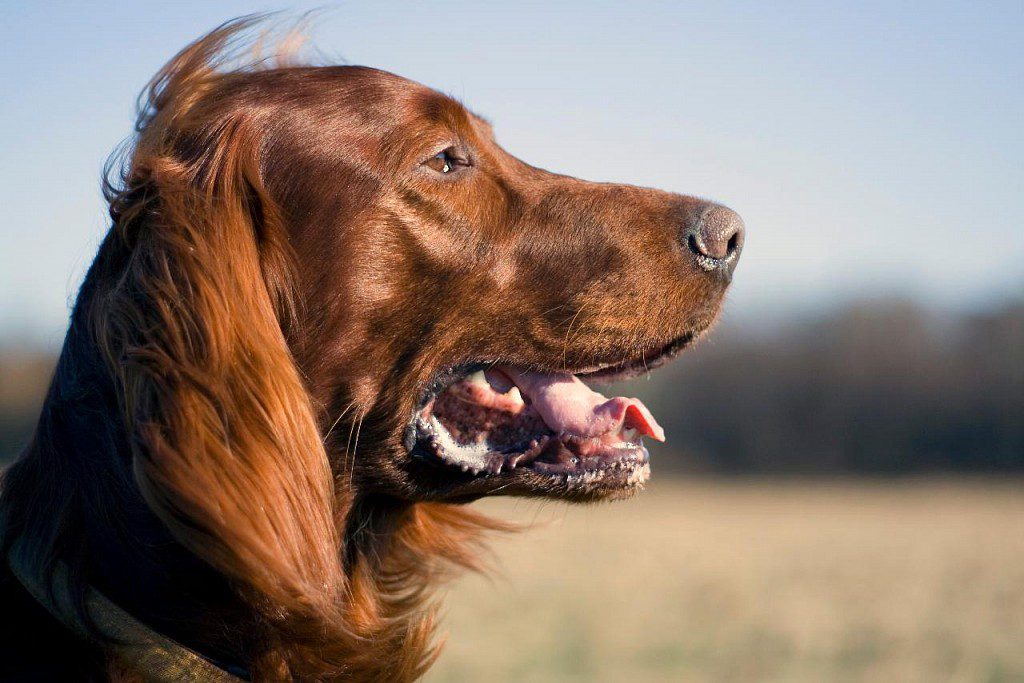

Jaws and bite
The upper and lower jaws of the Irish Setter have the same length and are closed in classic “scissors”.
Nose
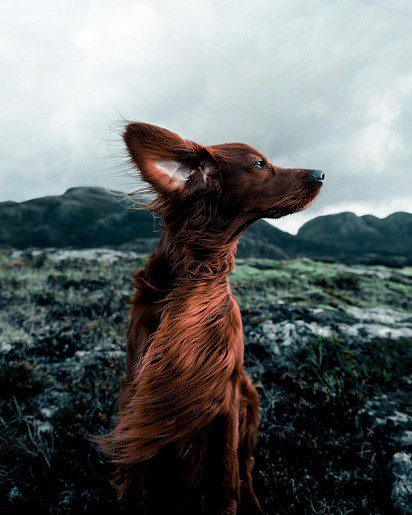

Lobe of medium size, nostrils wide open. Typical earlobes are dark walnut, jet black, dark mahogany.
Eyes
The oval, shallow-set eyes of the Irish Setter are characterized by a slightly slanted slit. The standard colors of the iris are dark brown and dark hazel.
Ears
Small, set low, very soft to the touch. The ear cloth has a rounded tip and hangs down along the cheekbones.
Neck
Slightly arched, of good length, fairly muscular, but not thick at all.
Frame
The body of the Irish Red Setter is well proportioned, with a deep, though rather narrow chest, a level back and a sloping, long croup. The abdomen and groin are highly tucked up.
limbs
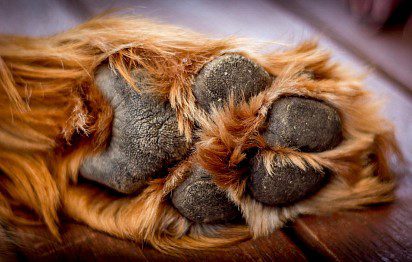

The forelegs are bony, sinewy, set parallel to each other. The shoulder blades are deep, the elbows are free, without obvious eversion to either side. Hind limbs of impressive length, well muscled. The articulation angles are correct, the area from the hock to the paw is massive and short. The paws of the dog are medium-sized, the fingers are strong, tightly assembled. The Irish Red Setter moves in a classic gallop, proudly tossing its head. The reach of the forelimbs of the animal is quite high, but without excessive throwing of the legs up, the push of the hind legs is powerful, springy and soft.
Tail
The Irish Setter has a moderately long (females are a couple of centimeters longer than males), low-set tail with a massive base and a relatively thin tip. The classic shape of the tail is straight or saber-shaped.
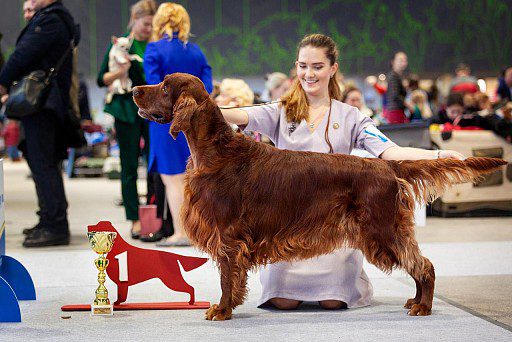

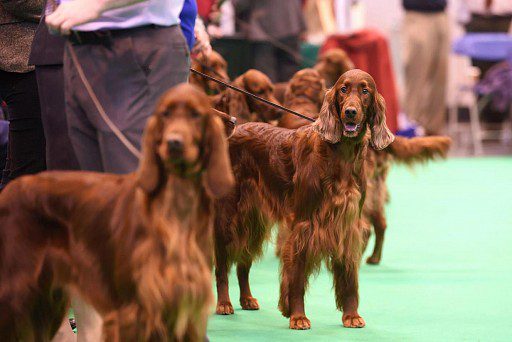

Wool
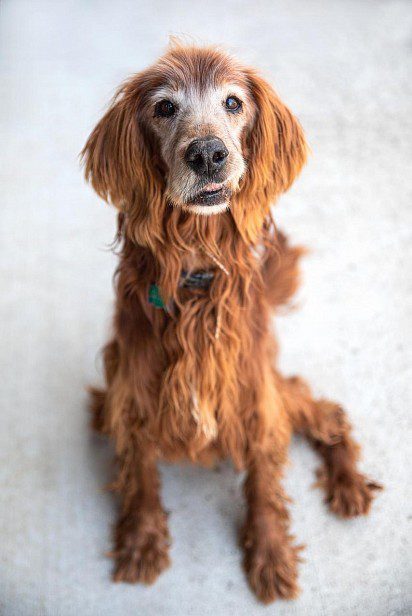

Adults are covered with a smooth, silky coat of medium length. On the front side of the forelegs, head and tips of the ear cloth, the hair is short, adjacent to the skin. The back side of all four limbs and the upper part of the ear cloth are “decorated” with a thin decorating hair. On the tail and belly, a rich fringe transforms into an exquisite fringe, often passing to the chest and throat area. There are tufts of feathers between the fingers.
Color
All dogs are chestnut with no hint of black undertones. Acceptable: small white marks on the throat, chest and forehead, or white blazes on the muzzle and nose.
Defects and disqualifying vices
Irish Red Setters may not meet the breed standard for various conformation characteristics. For example, it is undesirable for an animal to have such disadvantages as:
- long or curled coat;
- broad or unusually short head;
- curled up/burdocked ears.
Bulging, small or too close eyes, hump back, flat chest, thin crescent tail will also not be evaluated by breeding commissions. With regard to complete disqualification, it threatens individuals with cryptorchidism, owners of an atypical or black coat color, as well as dogs that lack dressing hair and depigmented lips, eyelids or nose.
Photo of Irish Setter
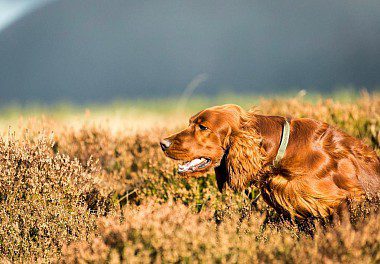

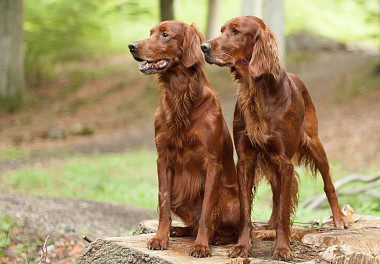

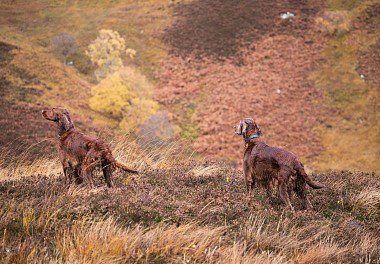

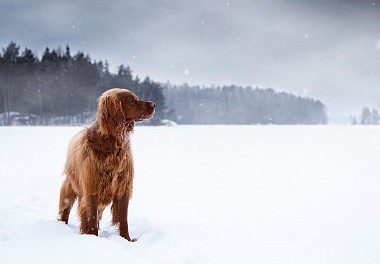

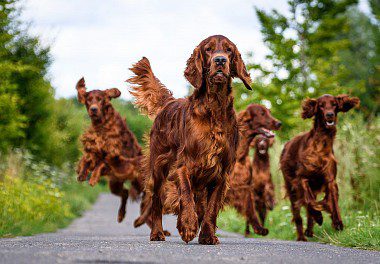

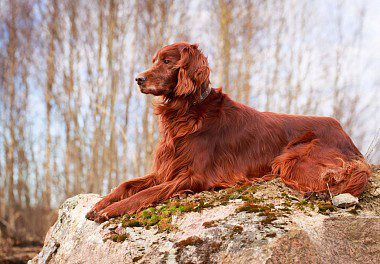

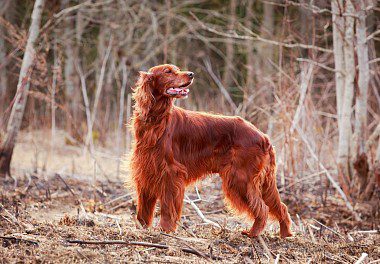

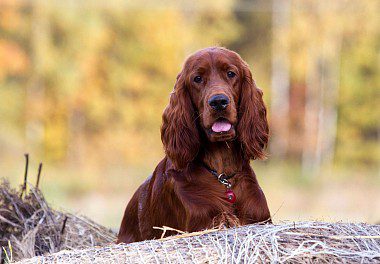

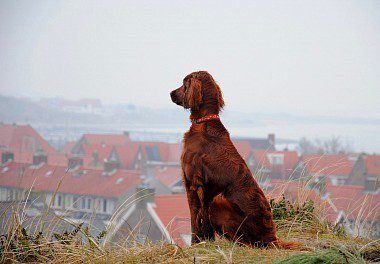

Personality of the Irish Setter
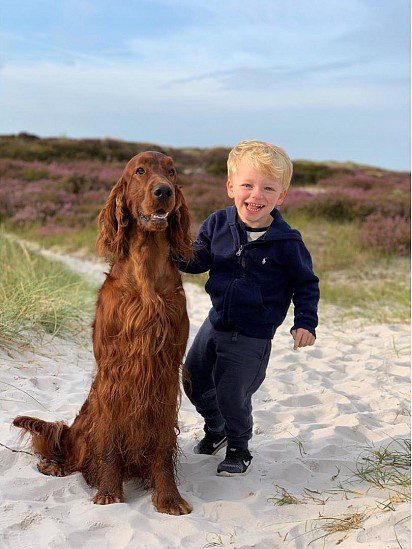

The Irish Setter is a dog whose internal battery runs in turbo mode from puppyhood to advanced age. And this applies not only to physical activity, but also to emotions, which the breed has a strategic reserve. If for the whole day the “Irish” did not manage to communicate with a single living creature (if there is no person – a cat will do), this is a serious reason for him to be upset.
Contact and friendly, Irish Red Setters are completely devoid of any kind of aggression. They do not expect a dirty trick from strangers and are generous towards children, even if they do not behave very politely. However, to perceive representatives of this breed as weak-willed mattresses is a big mistake. When necessary, the Irish Setter is able to show both stubbornness and strength of character. True, he will not do this assertively, but gradually, using cunning tricks, and sometimes obvious pretense. Trying to dominate a person is not typical for chestnut smarties (there are exceptions too), but they prefer to make decisions in everyday life on their own.
Irish Red Setters are not averse to “hang out” and easily fit into dog companies. They will also accept the second dog that appears in the house with “outstretched paws”, unless it is a jealous dominant type of Rottweiler or Boerboel . And yet, animals have the most sincere affection for humans, so before you get an Irish setter, think about whether you are ready to sacrifice a sofa rest for a book in favor of morning runs in any weather and whether you will not get tired of the amount of feelings and emotions which the dog considers it his duty to splash out on the owner. In particular, at home, the “Irish” love to follow the owner’s tail, unobtrusively, but persistently demanding affection, hugs and attention, and such pathological love is not treated with any strict commands or shouts.
Education and training
The Irish Red Setter is not without ability, although it does not have a reputation for being easy to train. The problem lies in the too lively temperament of the breed, which does not allow its representatives to concentrate on one object or type of activity for a long time. So, if you are planning to seriously engage in pet training, get ready to rack your brains over drawing up an individual training program that will not cause rejection in the dog.
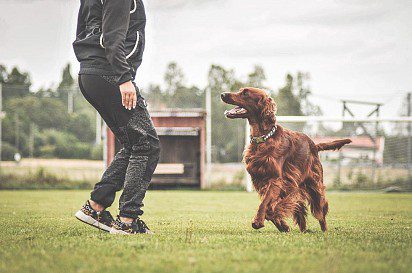

3.5-8 months is the optimal age for training an Irish Setter puppy. By this time, the kids are already aware of what a collective hierarchy is, so it is important to have time to let them know who is the real boss in the house and who is the “guy in the wings”. Teaching a pet the OKD and UGS commands is a mandatory measure, since the breed is prone to escaping. Particular attention is paid to working out the call “Come to me!”. The dog must react to it instantly and unquestioningly, although, as practice shows, this skill is most difficult for the animal to give.
With the rest of the teams, you can not be too zealous. The Irish Setter is not a Shepherd after all; pointing and mechanical work on the machine is not her forte. So, if the pet did not immediately fulfill the requirement or slightly altered it, this is already a reason to praise the animal. For such a self-sufficient and stubborn dog, this is a serious achievement.
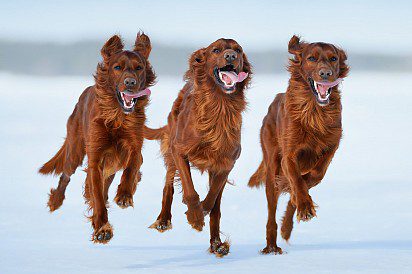

Setters are dependent on the owner’s approval, and this character trait can be a good thing to “leave” in cases where a four-legged pet evades classes. Show how upset you are by the dog’s unwillingness to work with you, and in a couple of minutes the remorse-ridden “Irish” will grind out another trick. Just do not abuse the dog’s complaisance: there are situations in which the Irish Setter will never make a concession. No, there will be no open protest, because the chestnut trickster does not like conflicts. But there will be masterfully played deafness to commands and universal misunderstanding in the eyes. It is necessary to treat such attacks with understanding, transferring the lesson to another time, but in no case completely abandoning the goal. Irish Setters are savvy guys who quickly figure out which levers to press,
Psychologically, the “natives of the country of leprechauns” remain puppies for a long time: hooligan, hyperactive, uncontrollable. You will have to come to terms with this fact, since punishment and an authoritarian style of communication are unacceptable for the breed and will only worsen the situation. But slightly correct the behavior of the baby is real. For example, physical activity is good at reducing the craving for adventures. A naughty man who has walked up to exhaustion usually has no strength left for pranks and only one desire arises – to take a nap in a corner.
Hunting with an Irish Setter
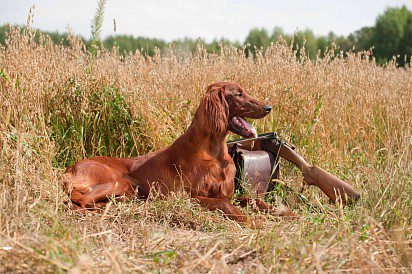

The main hunting prey of the Irish Red Setter are partridges, quails, corncrakes, black grouse, ducks and woodcocks. The breed is reckless, easy-going and relatively manageable, but not as patient as we would like. The dog works, relying mainly on instinct, using hearing and vision to a minimum. As a result: in the course of long aimless wanderings through the fields, the four-legged getter does not receive enough impressions, therefore, loses interest in work and switches to another type of activity. It is advisable to hunt with an Irish setter only in proven places where feathered trophies definitely live. If you need a more consistent and focused on the search process “scout”, it is better to pay attention to the English Setter.
Maintenance and care
In the past, a purely hunting breed, the Irish Setter is now increasingly positioned as a companion dog, which was not long in affecting the conditions of detention. The “Irish” no longer spend the night in barns and in the open air, and the care of their own wool was entrusted to the owners and groomers. The classic type of housing for a modern dog is a private house, preferably a country house, with a fenced yard. A more modest alternative is a comfortable bed in the apartment. Moreover, both options do not exclude intense physical activity, without which the four-legged “energizers” lose their taste for life and degrade.
Walk animals traditionally twice a day. Each such promenade lasts at least an hour, and preferably an hour and a half. By the way, the habit of enduring with the toilet before going outside is easy for smart setters, but it’s better not to go to extremes and additionally take the dog out to relieve itself – 10 minutes spent will save the pet from unnecessary torment.
Hygiene
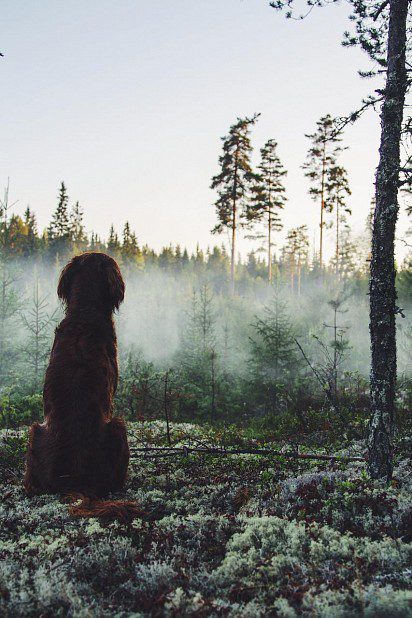

Get ready, you will have to mess with the hair of the Irish Setter a lot and often. First, because it is relatively long, especially in the abdomen, chest and tail. Secondly, because the smooth, silky hair of the setters is constantly falling off, tied into knots and tangled, along the way clinging to thorns and plant seeds. It will be especially difficult with representatives of exhibition lines, whose dog is an order of magnitude longer than that of hunting individuals. Show setters are combed daily, thoroughly working through the strands with a natural bristle brush.
You need to bathe the dog relatively often: once every 7-10 days. Usually, the washing process is preceded by the purchase of professional shampoos, conditioning compounds and natural oils to improve the structure of the coat. Without them, it is almost impossible to achieve a glamorous overflow on the coat of an Irish setter. The pet should be washed after its dog is thoroughly combed, and the tangles are dismantled, because after the bath it will be more difficult to do this.
To give the look more thoroughbred, Irish Red Setters are trimmed with thinning scissors. This is not a full-fledged haircut, but a slight thinning of the adorning wool, so do not get carried away too much, but rather entrust the job to the pros. During the off-season, when there is a lot of mud and puddles on the street, it is more expedient to walk the dog in protective overalls, which can be ordered from an online store or sewn on your own from waterproof fabric.
The ears, eyes and teeth of the animal are regularly cared for. The hanging ears of the Irish Red Setter are poorly ventilated, so, in addition to cleaning, they will have to be artificially ventilated – take the ear cloth by the edges and wave them vigorously. Claws for dogs are sheared 1-2 times a month: since the breed does not like to run on asphalt, preferring sandy paths and paths, they grind off weakly. By the way, it is best to do a “pedicure” to the Irish Setter after a bath, when the claw has softened under the action of steam and warm water. Of the mandatory procedures, it is also worth mentioning brushing your teeth (at least a couple of times a week) and daily wiping the mucous membrane of the eyes with herbal infusions (chamomile, tea).
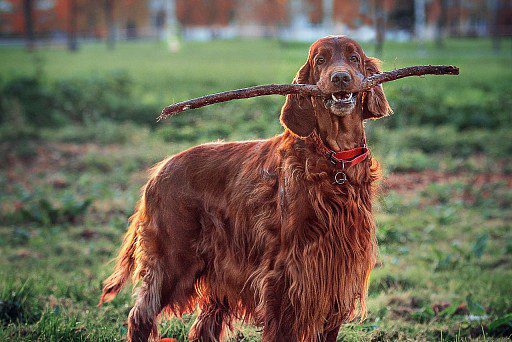

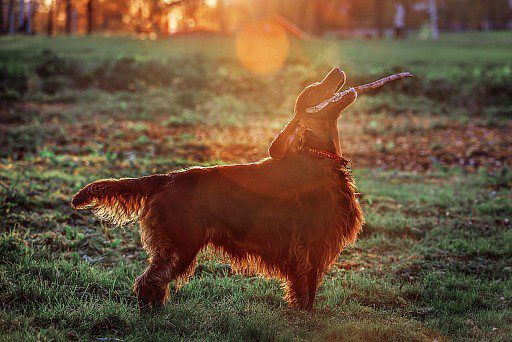

Feeding
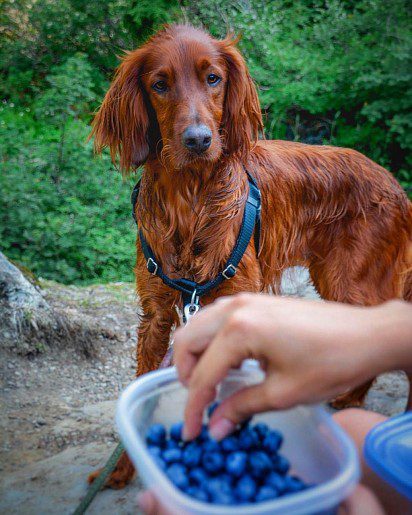

Start by getting your pet a bowl stand. The Irish Setter is not a squat breed, and it is simply harmful for her to bow at every meal, there is a risk of intestinal volvulus. Calculate the caloric content of the diet should be based on the level of physical activity received by the dog. For example, athletes and representatives of hunting lines who regularly travel to the field need to be fed denser than pets. In addition, Irish Setters are mostly small dogs, and this must be reckoned with. Of course, it is impossible to stuff more than the prescribed norm into the animal, but it is quite possible to make the portion more nutritious or choose the optimal food in terms of fat content (from 16% and above).
As for the natural menu for the breed, it does not differ in special originality. Substandard meat (based on 20 g per kilogram of animal body weight), offal, fish fillet – these are the three products that make up its base. From cereals, Irish red setters are useful buckwheat and oatmeal. By the way, puppies add cereal to meat or bone broth. Vegetables and fruits are given to dogs only seasonal – and no Asian exotic that can provoke an allergy attack. Additionally, adults can be treated with an omelette of two chicken eggs, low-fat sour milk and vegetable oil (about a teaspoon), plus vitamin supplements, selected and agreed with the veterinarian.
Irish Setter Health and Disease
The health of the breed depends on how responsibly the owner of the nursery approaches its breeding. The same hereditary diseases may not manifest themselves in animals whose breeder does not save on genetic testing of the litter, scrupulously selects sires for mating, and does not abuse inbreeding. And vice versa: Irish Setters, who are not too lucky with the owner and heredity, may show the following diseases:
- volvulus;
- epilepsy;
- hypothyroidism;
- malignant tumors (melanomas);
- entropion;
- hip dysplasia;
- allergic dermatitis;
- inflammatory processes in the uterus;
- spinal cord pathology (degenerative myelopathy);
- congenital expansion of the esophagus (idiopathic megaesophagus);
- hypertrophic osteodystrophy;
- paralysis of the larynx.
At the beginning of the 20th century, European breeders went too far with inbreeding, as a result of which the “Irish” suffered from progressive retinal atrophy for a long time. It was possible to eradicate the defect only after the development of a system of tests that helped identify the blindness gene in the early stages. Ultimately, defective individuals were no longer allowed to breed, which reduced the risk of transmission of the disease by inheritance.
How to choose a puppy


- The “girls” of the Irish Red Setter are more affectionate and accommodating, but the “boys” are richer “dressed” and have a textured appearance.
- To choose a good gun dog, it is better not to waste time on exhibitions, but immediately contact the hunting club that oversees working setter kennels.
- Working line puppies look more faded compared to their show counterparts. Their coat is lighter, shorter and rarer, and the puppies themselves are much smaller.
- When purchasing an Irish Red Setter puppy for exhibitions, it is worthwhile to thoroughly study the pedigrees of the producers. It is pointless to wait for a reference exterior from a baby whose parents do not have a single exhibition diploma.
- Find out where the puppies’ parents come from. Usually, domestic producers give offspring that are excellent in working qualities and very modest in external indicators. This is due to the fact that for over a hundred years Russian breeders have specialized in breeding hunting lines. If you need a puppy with exhibition potential, it is better to contact nurseries that practice mating imported individuals. There aren’t many of them, but they do exist.
- Depending on the place of breeding, there are two particularly successful show types of Irish setters: English and American. If you are an adherent of the classics in all its manifestations, it is better to give preference to the natives of Foggy Albion. At one time, American breeders went too far with the “upgrade” of the breed, which is why the appearance of their wards acquired a somewhat exaggerated look.
Photos of Irish Setter puppies
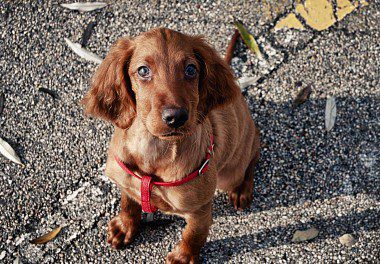



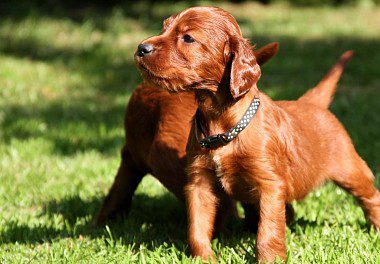



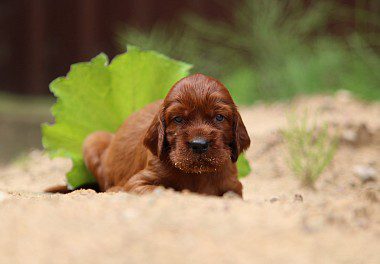

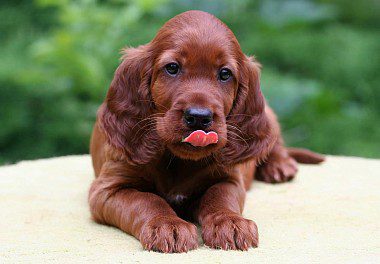

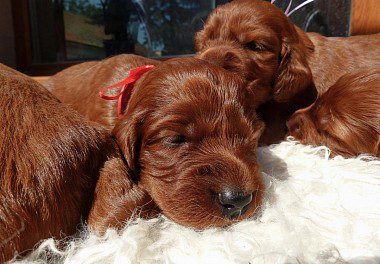

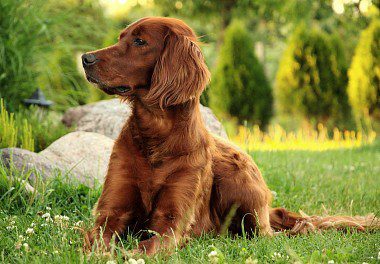



Irish Setter price
The average price of an Irish Red Setter puppy from a working line is 400 – 500$. Prices for representatives of the show class are higher – from 750$.





